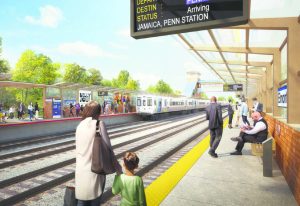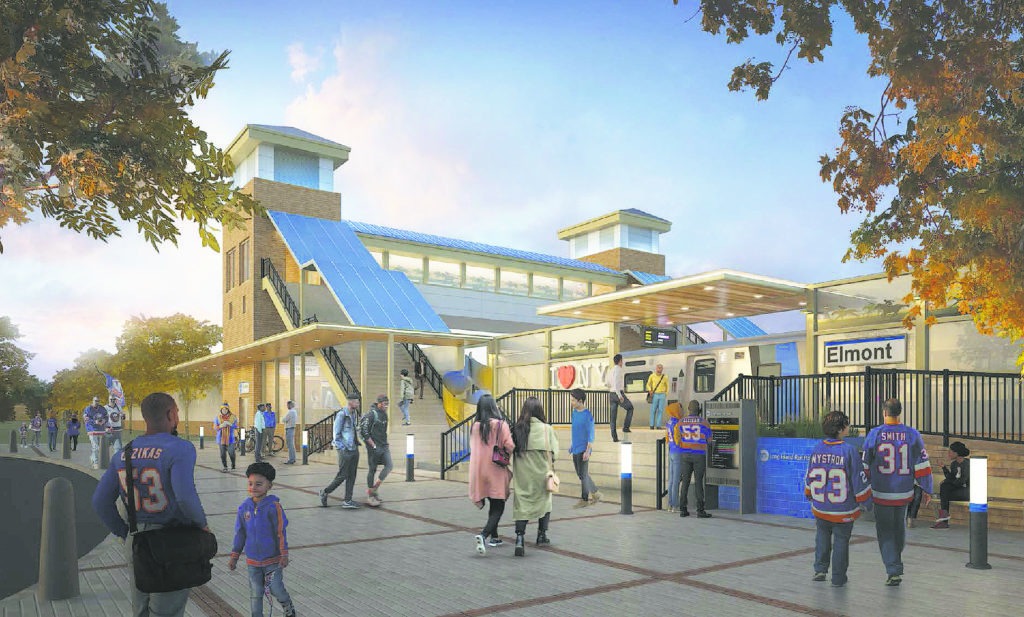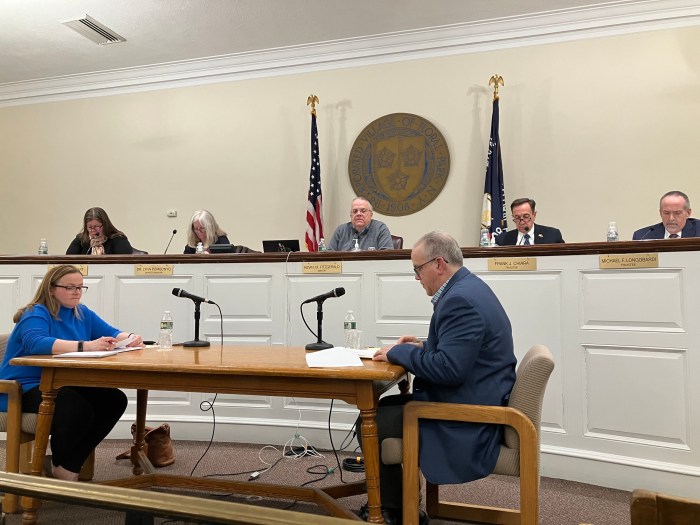 Next stop: Elmont. Last week, Governor Andrew Cuomo announced the transformational $1.26 billion Belmont Park redevelopment project, which includes a New York Islanders arena, mega-mall and hotel among other amenities, will benefit from a full-time Long Island Rail Road (LIRR) station. The new Elmont LIRR station will be the first full-time LIRR station in nearly 50 years, helping mitigate traffic concerns and providing a new amenity to the Elmont community. In addition, Cuomo released an analysis of the project’s economic impact, which found the new arena, hotel and retail village will generate nearly $50 million in public revenue per year and produce $725 million in annual economic output.
Next stop: Elmont. Last week, Governor Andrew Cuomo announced the transformational $1.26 billion Belmont Park redevelopment project, which includes a New York Islanders arena, mega-mall and hotel among other amenities, will benefit from a full-time Long Island Rail Road (LIRR) station. The new Elmont LIRR station will be the first full-time LIRR station in nearly 50 years, helping mitigate traffic concerns and providing a new amenity to the Elmont community. In addition, Cuomo released an analysis of the project’s economic impact, which found the new arena, hotel and retail village will generate nearly $50 million in public revenue per year and produce $725 million in annual economic output.
“The Belmont project will help drive the region’s economy forward while building the Islanders a state-of-the-art facility at home on Long Island, creating thousands of jobs and hundreds of millions of dollars in economic output along the way,” said Cuomo. “Now with the addition of the first full-time LIRR train station in almost 50 years, we will provide millions of visitors and fans a fast and affordable way to get there and continue New York’s nation-leading investments in 21st century transportation infrastructure.”
The Empire State Development (ESD), which is the umbrella organization for the state’s two principal economic development financing entities, the New York State Urban Development Corporation and the Department of Economic Development, has held many meetings about the redevelopment project. Due to vast community engagement, the ESD has now changed the project by reducing the maximum height of the hotel by 100 feet, reducing the project’s retail component from 435,000 square feet to 350,000 square feet, relocating a planned PSEG substation away from Floral Park-Bellerose Elementary School and committing to renovate local Elmont parks.
“This new train station is proof positive we listened to the community’s feedback and took action,” said ESD President, CEO and Commissioner Howard Zemsky. “Providing a direct ride to Belmont Park, the Islanders arena, the hotel and the retail village will drive even more New Yorkers and visitors to spend time on Long Island—boosting the regional economy with hundreds of millions of dollars.”
The New Station
The new Elmont LIRR train station will be located between the Queens Village and Bellerose stations on the LIRR’s main line. Electric shuttle buses, which are already planned to run from parking lots within Belmont Park to the Islanders arena, will also serve LIRR riders traveling to the grandstand, hotel and retail village. In addition, the new full-time station will relieve pressure on the existing Belmont spur station during major events like the highly anticipated Belmont Stakes.
Importantly, the new station will provide direct service to Belmont Park from both the east and west, as opposed to the LIRR spur, which only provides westbound service. Now, instead of forcing Long Islanders who are coming from the east of Belmont to ride past Belmont Park to Jamaica station and then transfer to a train that backtracks to the spur, travelers who live east of Belmont on the Hempstead, Oyster Bay, Port Jefferson and Ronkonkoma branches will have a ride straight to Belmont. This will reduce travel times and is expected to increase the number of event attendees, who use public transportation rather than driving to reduce congestion.
The new train station will also serve as an additional commuting option for area residents, which is something the community has needed for years. The station is expected to receive service approximately every half hour during peak times and hourly during off-peak periods. The parking lot north of the Belmont racetrack, which has 2,860 spaces, will be shared by commuters and arena patrons.
Previously-agreed-to upgrades to the existing LIRR Belmont spur, including the installation of automated track switches, are still included in the project. These upgrades will allow trains leaving the spur after an event to serve stations both east and west of Belmont—providing another mode of transportation for attendees.
Constructing the new full-time station on the LIRR’s main line and upgrading the existing spur is estimated to cost $105 million. The arena developers will cover $97 million, which is 92 percent of the total cost , while the state will invest $8 million.
“We are delighted by this plan, which allows us to provide full-time year-round service to the Elmont community and a second station at the redeveloped Belmont Park, all at no construction cost to the LIRR,” said LIRR President Phillip Eng. “This new station will allow us to provide direct service to Belmont from Long Island as well as from New York City with trains traveling on our Main Line, which is being expanded to a third track for greater service reliability and flexibility. I thank Governor Cuomo, Empire State Development and New York Arena Partners for their vision and commitment to public transportation.”
All On-board?
But, not everyone is convinced that the new Elmont LIRR train station is a good idea for the area.
“Cuomo claims that it will only cost $105 million to pay for a new full-time station between Bellerose and Queens Village on the main line and for the upgrades to the existing spur for part-time events at Belmont Park Arena Station,” said Larry Penner, a transportation historian, writer and advocate who previously worked for the United States Department of Transportation Federal Transit Administration Region 2 New York office. “What about costs to modify, upgrade or build new interlockings along the main line? How will this project be integrated with main line third track, Jamaica capacity improvements and other nearby LIRR capital and routine maintenance projects? Is there a detailed project budget, procurement strategy, force account plan, track outage plan and schedule to validate both the $105 million cost and project completion to coincide with the opening of the Islanders Belmont Arena, which is less than 27 months away?”
According to Penner, the station renderings show that the new station has only one overpass connecting the westbound and eastbound platforms.
“Will that provide safe and sufficient capacity for those who have to cross over?” asked Penner. “What will happen if there is a delay in service and crowds begin forming? Will the station be in compliance with Americans with Disability Act (ADA) and include bathrooms?”
Other questions that Penner proposed included the cost of LIRR tickets to the new Elmont station and whether or not it will be Zone 3 or 4, and which trains from the Hempstead, Oyster Bay, Port Jefferson and Ronkonkoma branches will serve the new station during the rush hour and non-rush hour.
The organization Elmont Against the Megamall said that they’ve been fighting for a train station in Elmont and while they’re glad to see a train station finally pop up in town, members say it still falls short.
“The location is approximately one-half mile from the proposed arena, which is way too far to walk for many people, especially in the winter and will require shuttle buses to get patrons to and from the station to the arena,” said board member Tony Bhatti. “The idea that people will wait around for shuttle buses, and then wait on a train that will take them to their home station, then get their cars to drive home is ridiculous. Inevitably, this frustrating experience will cause more patrons to drive to events, undercutting the point of the station. It should be built right into the arena as we proposed. I remain opposed to this proposal and will be working with my neighbors and our lawyers to weigh our options after we review the plans and supporting documents. This fight is not over.”
Floral Park Mayor Dominick Longobardi said that the village, which borders Belmont Racetrack in some of parts of the village, specifically the West End, is monitoring the new development closely.
“The Village of Floral Park is currently reviewing the latest information released by the ESD and Governor Cuomo regarding the Belmont Development Project,” said Longobardi. “The addition of the Elmont train station, the new Draft Traffic Management Plan and all of the responses to the issues and questions raised during the DEIS process require careful review to evaluate the impact on our village. We will continue to work closely with our legal and engineering team, our Belmont Task Force and our residents and businesses to ensure that this plan does not diminish the quality of life our residents and businesses have worked very hard to establish and maintain. As we’ve always said, this is a development project for Belmont Park. We welcome development at Belmont as long as it protects and improves Belmont and those surrounding communities without causing a reduction in anyone’s quality of life now or in the future.”


























